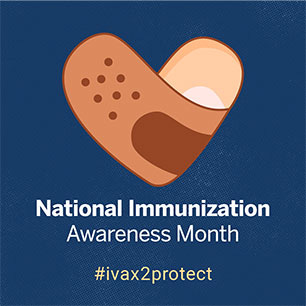Happy National Immunization Awareness Month
Each August we celebrate National Immunization Awareness Month. Throughout the month those of us in the medical and public health communities highlight the importance of vaccinations for all people of all ages.

As you prepare to send your children or grandchild back to school or as you prepare to return to the classroom yourself, be sure that everyone (this includes YOU) has had all of the recommended vaccinations.
Vaccines save lives.
In celebration of National Immunization Awareness Month — I am putting together a series of posts for the month of August focused on the history of vaccines, how the immune system works, the anatomy of a clinical trial (to test new vaccines), herd immunity, and three of my favorite vaccine-preventable disease. The goal of this series (which will include new posts each Wednesday) is to educate you about the immune system & immunity, how vaccines are developed, and the diseases that vaccines prevent. And with the knowledge gained, I want to empower you to become fully vaccinated AND an advocate for vaccines in your community.
Recently, the largest decline in the uptake of childhood vaccinations in 30 years was reported. Around the globe, we are seeing a decline in the uptake of important immunizations, including the DTP (diphtheria, tetanus, and pertussis) and HPV (human papillomavirus).
“First step in solving any problem is recognizing there is one.” -Will McAvoy in The Newsroom
Currently, there is a global vaccination crisis.
Too many people are unvaccinated or undervaccinated — meaning they are behind or missing specific vaccinations, which makes them vulnerable to vaccine-preventable diseases
Here is part #1 in the series celebrating National Immunization Awareness Month — the HISTORY OF VACCINATIONS
The process of vaccinating an individual to prevent illness is NOT new. During the 15th century, the Chinese observed that individuals who survived smallpox did not get the disease again. They decided to take the scabs from an individual with a mild case of smallpox, dry them, grind them into a powder, and blow the powder up the nose of healthy individuals who never had smallpox in the community. The safety and effectiveness of this early form of vaccination are unknown, but the Chinese were on the right track. They took a weakened version of the virus and gave it to healthy people to allow their immune systems to build antibodies.
The first published account of a successful vaccination was completed by Edward Jenner. In the 1700s, Jenner observed that milkmaids appeared to be immune to smallpox. Specifically, Jenner observed that milkmaids had perfect facial complexions (no pox scars), but often how cowpox marks on their hands. Jenner hypothesized that having a cowpox infection protected the milkmaids from contracting smallpox. So —Jenner extracted the puss from a cowpox pustule on the hand of a milkmaid, Sarah Nelmes, and vaccinated a young boy, James Phipps who had never had smallpox, with the puss. Jenner then exposed James to an individual with an active smallpox infection. James did not contract the disease.
Over the 18th and 19th centuries, a global smallpox immunization campaign culminated in the global eradication/elimination of smallpox in 1979.
Louis Pasteur (1822-1895) is responsible for the development of several other early vaccines, including a vaccine for anthrax and rabies. He tested the rabies vaccine on another young boy who had been bitten by a rabid dog in 1885. Spoiler: the vaccine worked and the boy lived (rabies is almost always fatal).
Germ theory, which originated with Pasteur, led to the official discovery of viruses in the 1890s. Viral tissue culture methods developed in the 1950s led to the development of the Salk (inactivated) polio vaccine in 1955 and the Sabin (live attenuated oral) polio vaccine in 1960. Mass polio immunization programs had eliminated the disease from many regions around the world. Unfortunately, we are seeing community spread of polio in many areas around the world that have not seen polio in decades.
Attenuated (aka weakened) strains of measles, mumps, and rubella (MMR) have been developed and combined into a single shot. Children receive several doses of the MMR vaccine in order to develop immunity to all three of those diseases. Measles is one of the next diseases that is being targeted for elimination via vaccination. But it will require a global effort to see measles eliminated from our communities.
Safe and effective vaccines are available to prevent the following diseases + COVID-19 in the United States —
Through vaccination programs, individual and community health can be improved.
Vaccines save lives.
Vaccines prevent illnesses and injuries.
Vaccines require that we take action before an illness occurs.
Vaccines are necessary for creating healthy communities.
Vaccines are not new; there is a long history of using weakened versions of a disease to prevent new infections in healthy individuals. We’ve come a long way since snorting smallpox scab powder! But the basic tenets of exposing healthy individuals to a weakened form of a disease in order to prevent future illnesses are still in place to improve individual and community health.
Being vaccinated is equivalent to being healthy.
You cannot have one without the other.
Get vaccinated.
And don’t be afraid to share with others that you are vaccinated!

There is also a rich history of clinical trials - the process by which vaccines are evaluated to ensure that they are safe and effective. We will discuss this history in two weeks in a post titled Anatomy of a Clinical Trial. Sign up so you don’t miss a post.
Have a question or comment about a specific vaccine or its development?







